2003 CHEVROLET ASTRO engine
[x] Cancel search: enginePage 109 of 386
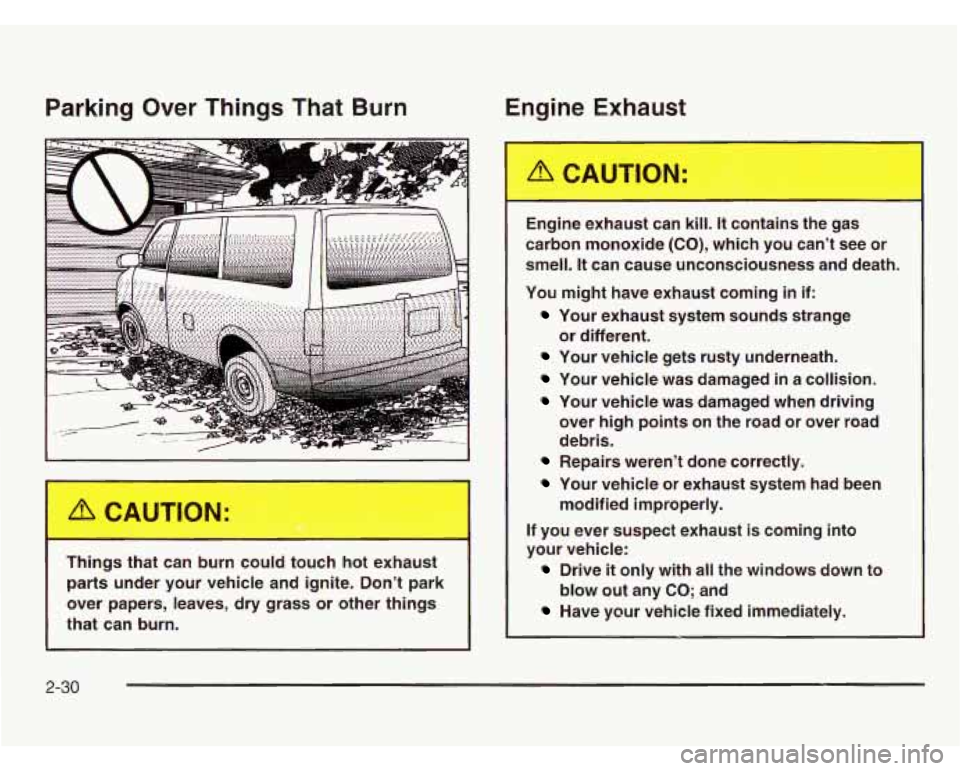
Parking Over Things That Burn
Things tha- Jan -Jrn could tout hot e: 3ust
parts under your vehicle and ignite. Don't park
over papers, leaves, dry grass or other things
that can burn. Engine exhaust can kill.
It contains the gas
carbon monoxide (CO), which you can't see or
smell.
It can cause unconsciousness and death.
You might have exhaust coming in if:
Your exhaust system sounds strange
Your vehicle gets rusty underneath.
Your vehicle was damaged in a collision.
Your vehicle was damaged when driving
over high points on the road or over road
debris.
or different.
Repairs weren't done correctly.
Your vehicle or exhaust system had
been
modified improperly.
If you ever suspect exhaust
is coming into
your vehicle:
Drive it only with all the windows down to
Have your vehicle fixed immediately.
blow out any
CO; and
2-30
Page 110 of 386
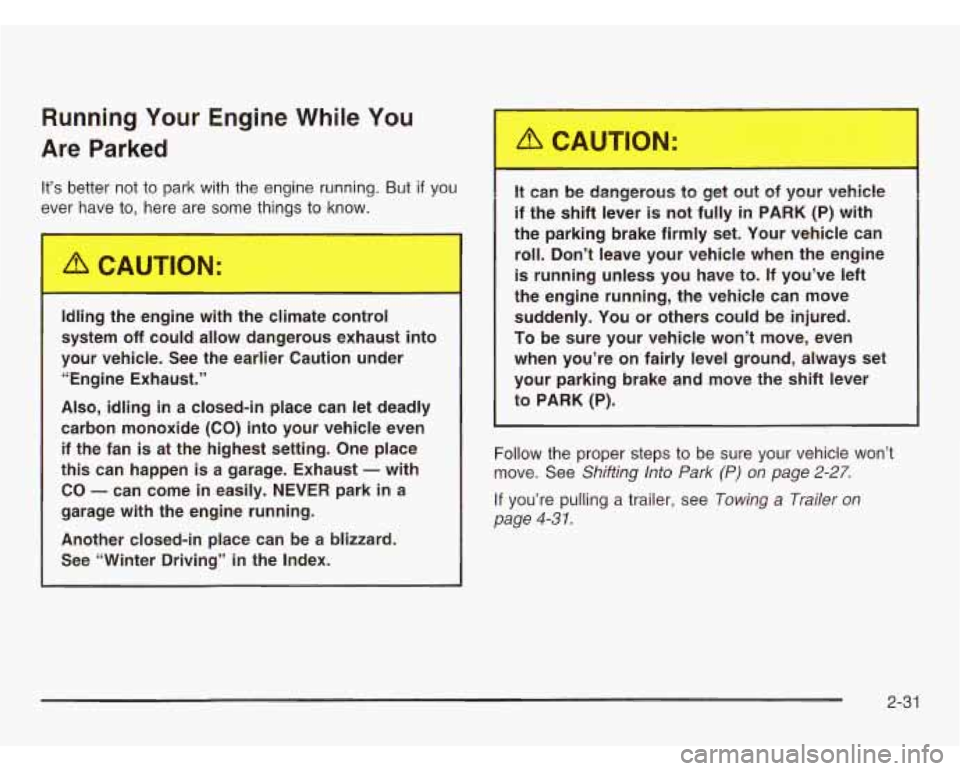
Running Your Engine While You
Are Parked
It’s better not to park with the engine running. But if you
ever have
to, here are some things to know.
I,..ng the e..,ine with the c
.... late conL ,I
system off could allow dangerous exhaust into
your vehicle. See the earlier Caution under
“Engine Exhaust.”
Also, idling in a closed-in place can let deadly
carbon monoxide
(CO) into your vehicle even
if the fan is at the highest setting. One place
this can happen
is a garage. Exhaust - with
CO - can come in easily. NEVER park in a
garage with the engine running.
Another closed-in place can be a blizzard. See “Winter Driving’’
in the Index.
L
It can be dangerous to get out of your vehicle
if the shift lever
is not fully in PARK (P) with
the parking brake firmly set. Your vehicle can
roll. Don’t leave your vehicle when the engine
is running unless you have to. If you’ve left
the engine running, the vehicle can move
suddenly. You or others could be injured.
To be sure your vehicle won’t move, even
when you’re on fairly level ground, always set
your parking brake and move the
shift lever
to
PARK (P).
Follow the proper steps to be sure your vehicle won’t
move. See
Shifting Into Park (P) on page 2-27.
If you’re pulling a trailer, see Towing a Trailer on
page
4-37.
2-31
Page 114 of 386
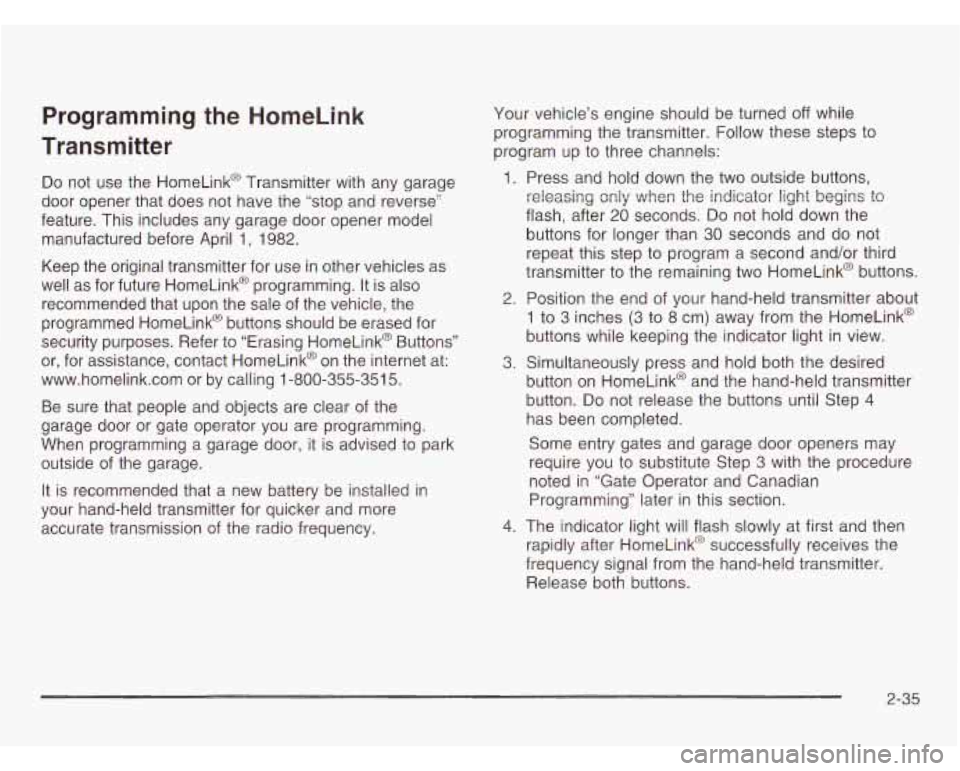
Programming the HomeLink
Transmitter
Do not use the HomeLink@ Transmitter with any garage
door opener that does not have the “stop and reverse”
feature. This includes any garage door opener model
manufactured before April
1, 1982.
Keep the original transmitter for use in other vehicles as
well as for future HomeLink@ programming. It is also
recommended that upon the sale of the vehicle, the
programmed HomeLink@ buttons should be erased for
security purposes. Refer to “Erasing HomeLink@ Buttons”
or, for assistance, contact HomeLinkO on the internet at:
www.home1ink.com or by calling 1-800-355-351 5.
Be sure that people and objects are clear of the
garage door or gate operator you are programming.
When programming a garage door, it is advised to park
outside of the garage.
It is recommended that a new battery be installed in
your hand-held transmitter for quicker and more
accurate transmission of the radio frequency. Your
vehicle’s engine should be turned
off while
programming the transmitter. Follow these steps
to
program up to three channels:
1. Press and hold down the two outside buttons,
releasing only when the indicator light begins
to
flash, after 20 seconds. Do not hold down the
buttons for longer than
30 seconds and do not
repeat this step
to program a second and/or third
transmitter to the remaining two HomeLink@ buttons.
2. Position the end of your hand-held transmitter about
1 to 3 inches (3 to 8 cm) away from the HomeLink@
buttons while keeping the indicator light in view.
3. Simultaneously press and hold both the desired
button on HomeLink@ and the hand-held transmitter
button.
Do not release the buttons until Step 4
has been completed.
Some entry gates and garage door openers may
require you to substitute Step 3 with the procedure
noted in “Gate Operator and Canadian
Programming’’ later in this section.
4. The indicator light will flash slowly at first and then
rapidly after HomeLink@ successfully receives the
frequency signal from the hand-held transmitter.
Release both buttons.
2-35
Page 117 of 386
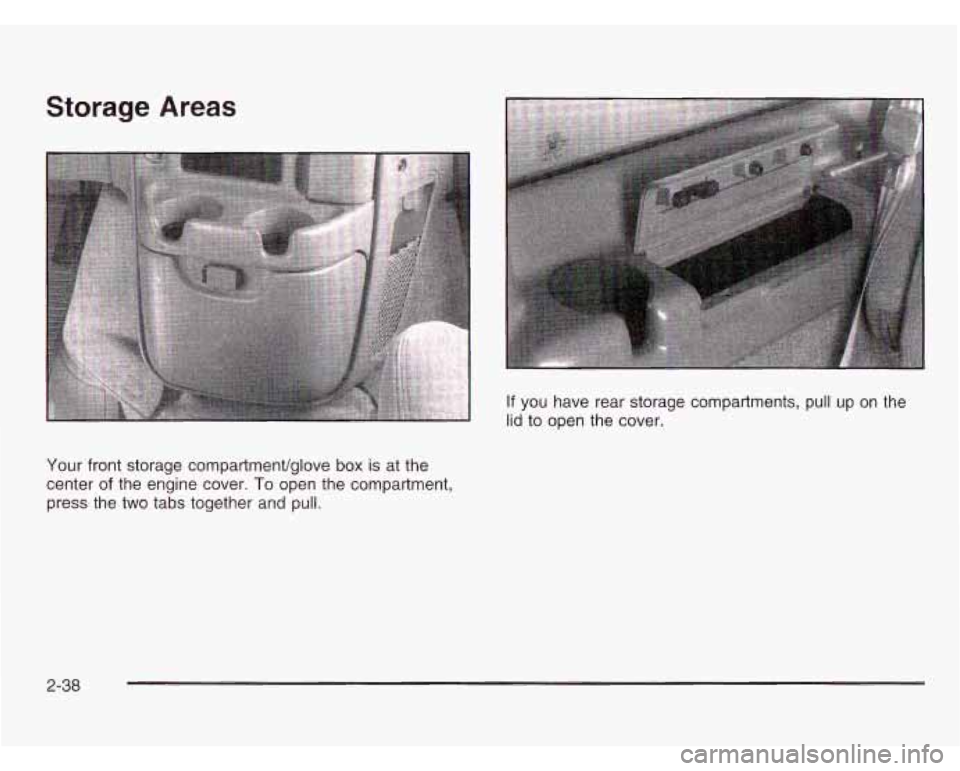
Storage Areas
If you have rear storage compartments, pull up on the
lid to open the cover.
Your front storage compartmenVglove box
is at the
center
of the engine cover. To open the compartment.
press the two tabs together and pull.
2-38
Page 118 of 386

There is also a mapktorage pocket on the passenger's
side of the engine cover console. Your
vehicle may have this feature.
The overhead console includes reading lamps,
a compartment for a garage door opener, a trip
computer, a temperature and compass display, and a
storage compartment for sunglasses.
The reading lamps, trip computer, temperature and
compass display will work when the ignition is in
RUN,
ACCESSORY or when Retained Accessory Power (RAP)
is active. See "Retained Accessory Power" under
lgnition
Positions on
page 2- 19.
2-39
Page 126 of 386

Section 3 Instrument Panel
Instrument Panel Overview ............................... 3.2
Hazard Warning Flashers
................................ 3-4
Other Warning Devices
................................... 3-5
Horn
............................................................. 3-5
Tilt Wheel
..................................................... 3-5
Turn SignaVMultifunction Lever
......................... 3.6
Exterior Lamps
.......................................... 3.12
Interior Lamps
................................ ....... 3.15
Accessory Power Outlets
............................... 3.16
Ashtrays and Cigarette Lighter
........................ 3.17
Climate Controls ............................................ 3.18
Climate Control System
................................. 3.18
Rear Heating System
................................... -3-1 9
Rear Air Conditioning System ......................... 3.20
Rear Climate Control System
......................... 3.21
Warning Lights, Gages and Indicators ............. 3.23
Instrument Panel Cluster
................................ 3.24
Speedometer and Odometer
........................... 3.25
Safety Belt Reminder Light
............................. 3.26
Air Bag Readiness Light
................................ 3-26
Charging System Light
.................................. 3.27
Voltmeter Gage
........................................... -3-28
Brake System Warning Light
.......................... 3.28 Anti-Lock
Brake System Warning Light
............. 3.29
Engine Coolant Temperature Gage
= = =. ~ = = ~ ~ ~ = i. 3-39
Malfunction Indicator Lamp
............................. 3.30
Oil Pressure Gage
........................................ 3.34
Security Light
.............................................. -3-35
Service All-Wheel Drive Light
......................... 3.35
Tow/Haul Mode Light
......... ................... 3.36
Fuel Gage
................................................... 3.36
Low Fuel Warning Light
................................. 3.37
Audio System@) ............................................. 3.38
Setting the Time for Radios with
the Set Button
.......................................... 3-38
Setting the Time for Radios with
HR and MN Buttons .................................. 3-38
AM-FM Radio
............................................... 3.39
Radio with CD
.............................................. 3-41
Theft-Deterrent Feature
........... ................ 3.47
Understanding Radio Reception
................... 3.50
Care of Your CDs
......................................... 3-50
Care of Your CD Player
................................ 3-50
Fixed Mast Antenna
...................................... 3.50
Check Gages Warning
Light
........................... 3-36
Rear Seat Audio (RSA)
. . .... ............ 3.46
3-
1
Page 142 of 386
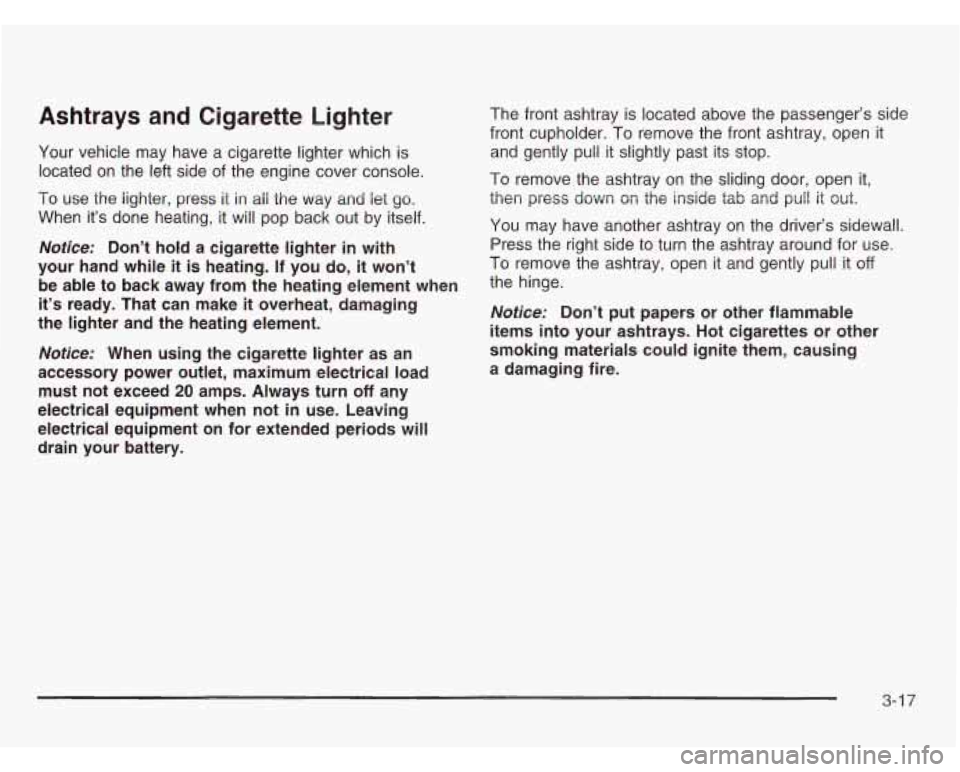
Ashtrays and Cigarette Lighter
Your vehicle may have a cigarette lighter which is
located on the left side
of the engine cover console.
To use the lighter, press it in ail the way and let go.
When it’s done heating, it will pop back out by itself.
Notice: Don’t hold a cigarette lighter in with
your hand while
it is heating. If you do, it won’t
be able to back away from the heating element when
it’s ready. That can make
it overheat, damaging
the lighter and the heating element.
Notice: When using the cigarette lighter as an
accessory power outlet, maximum electrical load must not exceed 20 amps. Always turn
off any
electrical equipment when not
in use. Leaving
electrical equipment on for extended periods will
drain your battery. The
front ashtray
is located above the passenger’s side
front cupholder. To remove the front ashtray, open it
and gently pull it slightly past its stop.
To remove the ashtray on the sliding door, open it,
then press down
on the inside tab and pull it out.
You may have another ashtray on the driver’s sidewall.
Press the right side to turn the ashtray around for use.
To remove the ashtray, open it and gently pull it off
the hinge.
Notice: Don’t put papers or other flammable
items into your ashtrays. Hot cigarettes or other
smoking materials could ignite them, causing
a damaging fire.
3-1 7
Page 146 of 386
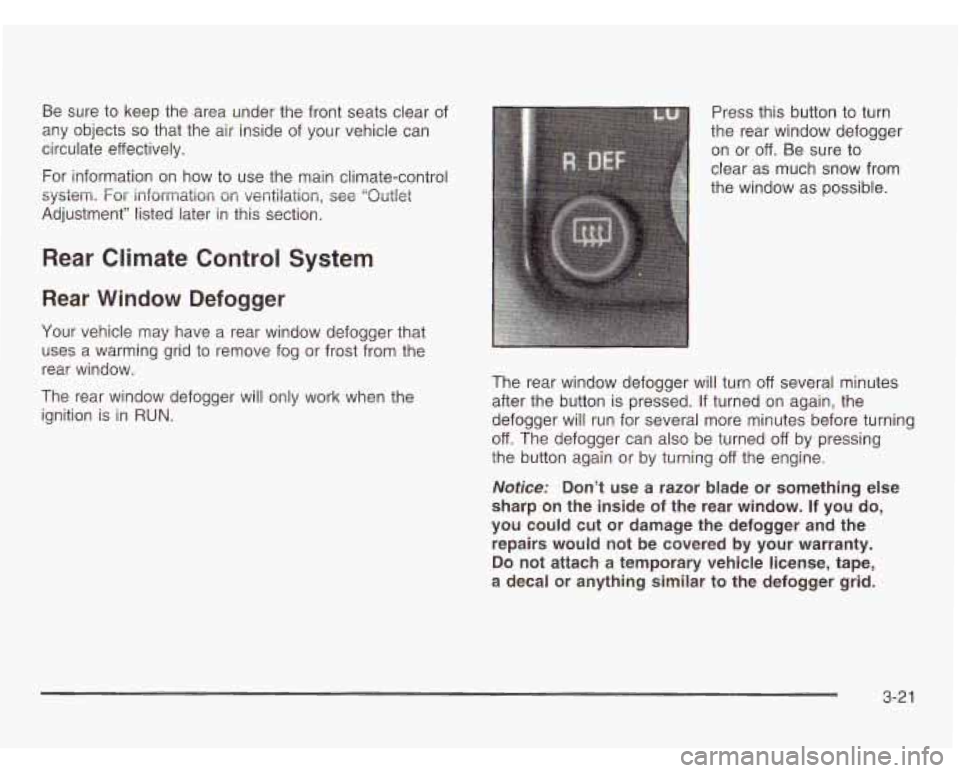
Be sure to keep the area under the front seats clear of
any objects
so that the air inside of your vehicle can
circulate effectively.
For information on how to use the main climate-control
system. For information
on ventilation, see “Outlet
Adjustment” listed later in this section.
Rear Climate Control System
Rear Window Defogger
Your vehicle may have a rear window defogger that
uses a warming grid
to remove fog or frost from the
rear window.
The rear window defogger will only work when the
ignition is in
RUN.
Press this button to turn
the rear window defogger
on or off. Be sure to
clear as much snow from
the window as possible.
The rear window defogger will turn
off several minutes
after the button is pressed. If turned on again, the
defogger will run for several more minutes before turning
off. The defogger can also be turned off by pressing
the button again or by turning off the engine.
Notice: Don’t use a razor blade or something else
sharp on the inside of the rear window. If you do,
you could cut or damage the defogger and the repairs would not be covered by your warranty.
Do not attach a temporary vehicle license, tape,
a decal or anything similar to the defogger grid.
3-2 1